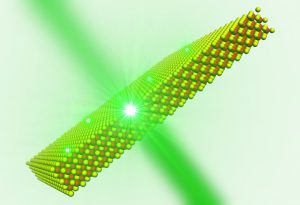A research team led by Prof. Hilmi Volkan Demir of UNAM and the Departments of Electrical and Electronics Engineering and Physics has reported a discovery that shows great promise for advancing laser technology.

Today lasers are being used everywhere, from fiberoptic communications and data storage to medicine and autonomous vehicles. In lasers, the lasing action happens in an optical gain medium. An important benchmarking parameter for laser gain media is the optical gain coefficient. This parameter measures the capability of the medium to amplify light via stimulated emission. In prototypical laser gain media, modal gain (i.e., the net optical gain coefficient) is in the range of 10–100 cm-1. Only a few select systems have been able to realize modal gain larger than 1000 cm-1.
In a recent article titled “Giant Modal Gain Coefficients in Colloidal II–VI Nanoplatelets,” which appeared in the January 9 issue of the American Chemical Society’s Nano Letters journal, Prof. Demir’s team reported giant modal gain coefficients that they discovered in a nanomaterial-based gain medium. This gain system consists of a thin, solid film of atomically flat semiconductor nanocrystals, nicknamed “nanoplatelets.” Synthesized in Prof. Demir’s laboratory using a low-temperature colloidal method, these nanoplatelets can be deposited on essentially any arbitrary surface at room temperature. In their study, Prof. Demir and his coworkers found that the modal gain coefficients in the nanoplatelets reach a level of
6,600 cm-1, marking one of the largest modal gains measured to date. This is enabled by the superior optoelectronic properties of the colloidal nanoplatelets. In addition, intrinsic material gain in the nanoplatelets is estimated to be 15,300 cm-1 at room temperature, which is on a par with the best reported semiconductor gain media so far.
Setting a new record for all colloids, this ultra-large gain makes such atomically flat nanocrystals highly promising for future laser technologies. The scientific findings presented by the team in the article indicate that such tailor-made nanomaterials can provide optical gain performance as competitive as the prototypical gain media employed in semiconductor lasers. Moreover, the low cost of production and the ease of processing these nanoplatelets offer important competitive advantages over conventional semiconductors, which are typically grown via expensive methods such as gas-phase epitaxy and can be deposited only on certain surfaces. The research group will be continuing their investigation with a view toward the development of electrically driven nanoplatelet-based lasers.
